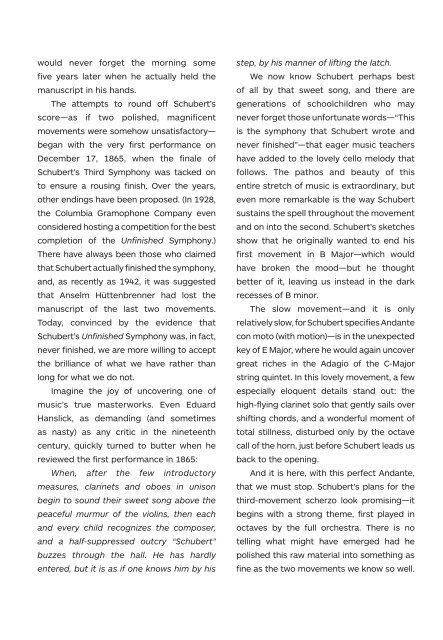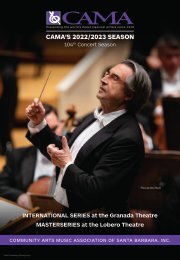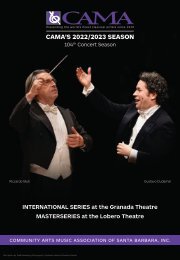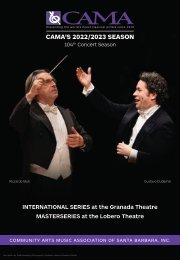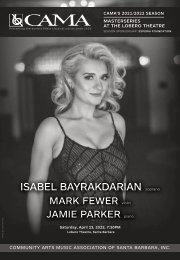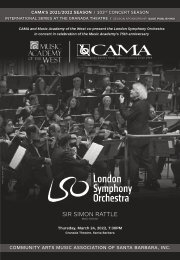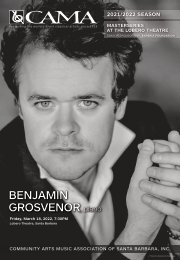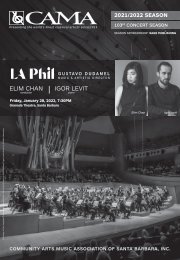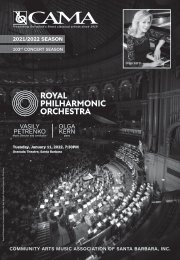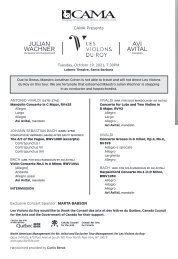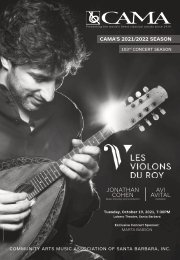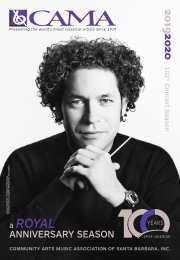CAMA presents Chicago Symphony Orchestra - October 21, 2017 - International Series at The Granada Theatre
Chicago Symphony Orchestra Saturday, October 21, 2017, The Granada Theatre, 8pm Riccardo Muti Music Director Stephen Williamson Clarinet Franz Schubert: Symphony No.8, D.759, “Unfinished” Wolfgang Amadeus Mozart: Clarinet Concerto in A Major, K.622 Robert Schumann: Symphony No.2 in C Major, Op.61 Not seen in Santa Barbara since 1987, the Chicago Symphony Orchestra is consistently hailed as one of the greatest orchestras in the world. In collaboration with the best conductors and guest artists on the international music scene, the CSO performs well over one hundred concerts each year at its downtown home, Symphony Center and at the Ravinia Festival on Chicago’s North Shore. Music lovers outside Chicago enjoy the sounds of the Chicago Symphony Orchestra through best-selling recordings and sold-out tour performances in the United States and around the globe. Maestro Riccardo Muti is one of the preeminent conductors of our day. In 2010, when he became the tenth music director of the Chicago Symphony Orchestra (CSO), he already had more than forty years of experience at the helm of the Maggio Musicale Fiorentino, Philharmonia Orchestra, Philadelphia Orchestra, and Teatro alla Scala.
Chicago Symphony Orchestra
Saturday, October 21, 2017, The Granada Theatre, 8pm
Riccardo Muti Music Director
Stephen Williamson Clarinet
Franz Schubert: Symphony No.8, D.759, “Unfinished”
Wolfgang Amadeus Mozart: Clarinet Concerto in A Major, K.622
Robert Schumann: Symphony No.2 in C Major, Op.61
Not seen in Santa Barbara since 1987, the Chicago Symphony Orchestra is consistently hailed as one of the greatest orchestras in the world. In collaboration with the best conductors and guest artists on the international music scene, the CSO performs well over one hundred concerts each year at its downtown home, Symphony Center and at the Ravinia Festival on Chicago’s North Shore. Music lovers outside Chicago enjoy the sounds of the Chicago Symphony Orchestra through best-selling recordings and sold-out tour performances in the United States and around the globe. Maestro Riccardo Muti is one of the preeminent conductors of our day. In 2010, when he became the tenth music director of the Chicago Symphony Orchestra (CSO), he already had more than forty years of experience at the helm of the Maggio Musicale Fiorentino, Philharmonia Orchestra, Philadelphia Orchestra, and Teatro alla Scala.
You also want an ePaper? Increase the reach of your titles
YUMPU automatically turns print PDFs into web optimized ePapers that Google loves.
would never forget the morning some<br />
five years l<strong>at</strong>er when he actually held the<br />
manuscript in his hands.<br />
<strong>The</strong> <strong>at</strong>tempts to round off Schubert’s<br />
score—as if two polished, magnificent<br />
movements were somehow uns<strong>at</strong>isfactory—<br />
began with the very first performance on<br />
December 17, 1865, when the finale of<br />
Schubert’s Third <strong>Symphony</strong> was tacked on<br />
to ensure a rousing finish. Over the years,<br />
other endings have been proposed. (In 1928,<br />
the Columbia Gramophone Company even<br />
considered hosting a competition for the best<br />
completion of the Unfinished <strong>Symphony</strong>.)<br />
<strong>The</strong>re have always been those who claimed<br />
th<strong>at</strong> Schubert actually finished the symphony,<br />
and, as recently as 1942, it was suggested<br />
th<strong>at</strong> Anselm Hüttenbrenner had lost the<br />
manuscript of the last two movements.<br />
Today, convinced by the evidence th<strong>at</strong><br />
Schubert’s Unfinished <strong>Symphony</strong> was, in fact,<br />
never finished, we are more willing to accept<br />
the brilliance of wh<strong>at</strong> we have r<strong>at</strong>her than<br />
long for wh<strong>at</strong> we do not.<br />
Imagine the joy of uncovering one of<br />
music’s true masterworks. Even Eduard<br />
Hanslick, as demanding (and sometimes<br />
as nasty) as any critic in the nineteenth<br />
century, quickly turned to butter when he<br />
reviewed the first performance in 1865:<br />
When, after the few introductory<br />
measures, clarinets and oboes in unison<br />
begin to sound their sweet song above the<br />
peaceful murmur of the violins, then each<br />
and every child recognizes the composer,<br />
and a half-suppressed outcry “Schubert”<br />
buzzes through the hall. He has hardly<br />
entered, but it is as if one knows him by his<br />
step, by his manner of lifting the l<strong>at</strong>ch.<br />
We now know Schubert perhaps best<br />
of all by th<strong>at</strong> sweet song, and there are<br />
gener<strong>at</strong>ions of schoolchildren who may<br />
never forget those unfortun<strong>at</strong>e words—“This<br />
is the symphony th<strong>at</strong> Schubert wrote and<br />
never finished”—th<strong>at</strong> eager music teachers<br />
have added to the lovely cello melody th<strong>at</strong><br />
follows. <strong>The</strong> p<strong>at</strong>hos and beauty of this<br />
entire stretch of music is extraordinary, but<br />
even more remarkable is the way Schubert<br />
sustains the spell throughout the movement<br />
and on into the second. Schubert’s sketches<br />
show th<strong>at</strong> he originally wanted to end his<br />
first movement in B Major—which would<br />
have broken the mood—but he thought<br />
better of it, leaving us instead in the dark<br />
recesses of B minor.<br />
<strong>The</strong> slow movement—and it is only<br />
rel<strong>at</strong>ively slow, for Schubert specifies Andante<br />
con moto (with motion)—is in the unexpected<br />
key of E Major, where he would again uncover<br />
gre<strong>at</strong> riches in the Adagio of the C-Major<br />
string quintet. In this lovely movement, a few<br />
especially eloquent details stand out: the<br />
high-flying clarinet solo th<strong>at</strong> gently sails over<br />
shifting chords, and a wonderful moment of<br />
total stillness, disturbed only by the octave<br />
call of the horn, just before Schubert leads us<br />
back to the opening.<br />
And it is here, with this perfect Andante,<br />
th<strong>at</strong> we must stop. Schubert’s plans for the<br />
third-movement scherzo look promising—it<br />
begins with a strong theme, first played in<br />
octaves by the full orchestra. <strong>The</strong>re is no<br />
telling wh<strong>at</strong> might have emerged had he<br />
polished this raw m<strong>at</strong>erial into something as<br />
fine as the two movements we know so well.


